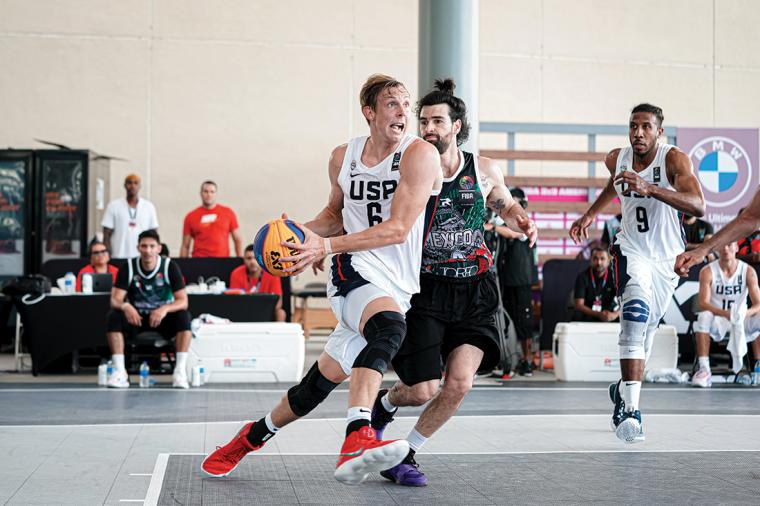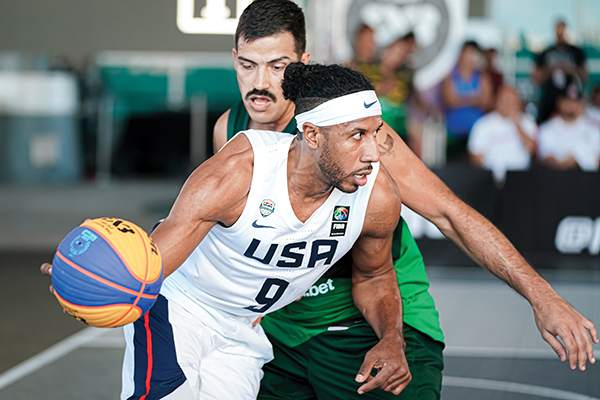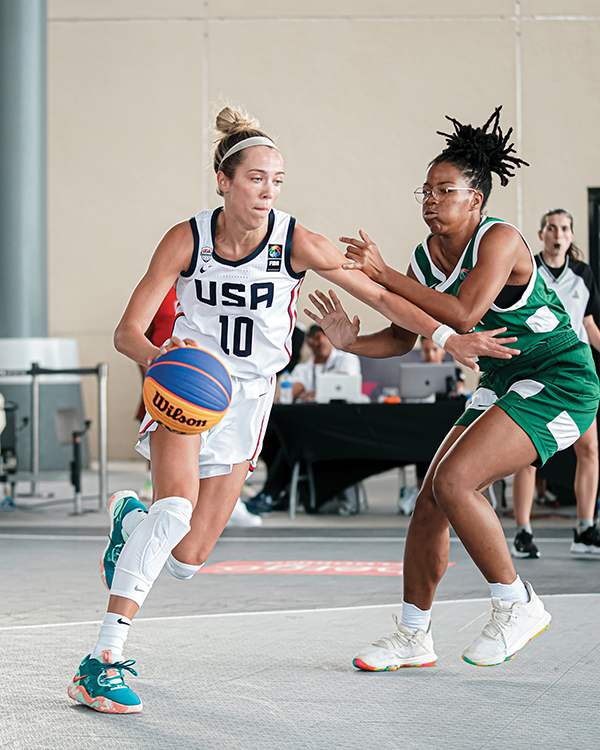
One of the newest Olympic disciplines, 3x3 basketball (where the U.S. Womenís Team won gold), emerged as the breakout star among TV viewers. Itís fast-paced, takes up less court space, has its roots in the urban game, has multiple sponsored tours ñ and people tuned in to watch it in the Games. Since that time, 3x3 has gained visibility, and the discipline will be featured in the Games in Paris in 2024.
(Editorial note: It’s pronounced “three-ex-three,” not three-by-three, three-on-three, three-times-three or any other permutation.) From an organizational perspective, 3x3 is easy to implement. It takes a half-court, one net and six players total. (In formal competition, each team has four players, three of whom are on the court, and one substitute). Each game is capped at 10 minutes and the first team to reach 21 points wins, making it easy – and less time-consuming – to watch.
Jay Demings, USA Basketball Youth & Sport Development Director, sat down with SDM to explain the organization’s continuing efforts to grow the discipline.
The Challenges of Qualifying for the Olympics

In this Olympic cycle, which will be the second time 3x3 is featured, the qualification system hinges on athletes who play an entire season of 3x3 (many events are held overseas) and attempting to gain a certain number of points in the ranking system.
Olympic qualification means the U.S. would need to finish top three in the FIBA World Ranking system in total points earned. The cut-off date to earn points is Nov. 1, 2023 (competition begins in May). If in November, we haven’t qualified, we will need to play in additional tournaments – but we are optimistic that we will not have to do that.
In the last cycle, because of COVID, teams could not continue to go overseas to play one another so we had to improvise. We were fortunate to have some very talented players who wanted to play 3x3 and we were able to work with them to get them trained and ready. This time around, players have some tough decisions to make. They can stay with 5x5, the game they’ve always known, and continue to play in the NBA or WNBA or even overseas – but if they do that, they can’t also play 3x3.
USA Basketball will put together upwards of 20 men’s and women’s 3x3 teams this year, with the goal of earning points to attain an Olympic qualification bid. Currently, those teams are expected to compete in between 60 and 80 events. The 2023 calendar includes 3X Nationals, the FIBA 3x3 Men’s World Tour, the FIBA 3x3 Women’s Series, a trio of World Cups (senior, U23, U18), two Nations League (U23 and U21), the Pan American Games, the 3x3 AmeriCup and others. Each competition will help the USA, both as a federation and its individual athletes, earn the points needed to qualify.
The Public’s Disconnect in Understanding 3x3
Sometimes people don’t understand how it is that the USA, where arguably some of the best basketball athletes in the world can be found, can’t just take athletes out of its professional programs (or even its college programs) and put them onto a 3x3 team. We see a lot of those comments on social media; largely it’s because people not only do not understand the qualification process for the Olympics, but they simply don’t understand 3x3.
3x3 is a different game entirely and being good at 5x5 does not necessarily translate to being a good 3x3 player. In 3x3, you’re using an entirely different mindset; you’re playing both offense and defense, the game is very fast and you’re going to be handling the ball a lot more. It’s almost impossible to switch back and forth between both disciplines and to play both at the level that is needed for the Olympics (or the pros, for that matter).
Awareness of 3x3
The really good news is that the success the USWNT in 3x3 had in Tokyo has definitely translated into increased awareness. Players at the Games saw their notoriety increase, and they went on to have great seasons following their return.
Something interesting is that awareness of, and enthusiasm for, 3x3 is growing in the U.S. The game appears to be growing in pockets and there is increased participation at the grassroots level, particularly among youth. 3x3 is often used as a training tool for 5x5, but what kids are finding out is that if they can play 3x3, they can pretty much do anything on the court. It really increases their skillset and their intelligence as a player.
The Travel Market for 3x3

Basketball in its traditional 5x5 form is incredibly popular on the travel tournament circuit. Unfortunately, tournament operators have struggled to figure out how to promote 3x3 as its own discipline and still be able to monetize it successfully. For example, if you are charging X as a registration fee for one team that has 10 or 12 players, you can divide that registration fee among all of those players and it’s fairly affordable for the parents. In 3x3, you’re dividing the fee among four players at the most, so it costs more and it’s a tougher sell.
Of course, on the other hand, there are economic advantages to 3x3 events. As an event owner, you’ll be using half the number of facilities you typically do because one court can host two games simultaneously. Games are quick (10 minutes long) so you’ll be running multiple games over the same courts in a lot less time. You only need one or possibly two officials to call each 3x3 game. (Unfortunately, you also need officials who are trained in 3x3 since the rules are different.)
In Europe and Asia, the travel tournament circuit is incredibly strong and it has made 3x3 very popular. I see 3x3 travel here as the next frontier.
Outside the Youth Arena
Basketball as a youth sport is deeply rooted in our culture but another growth opportunity we’re seeing now is among young adults who were student athletes when they were in high school and college, and who now miss playing and being part of a team. There are a lot of leagues for men and women, as well as a great deal of pickup basketball. 3x3 is great for this because you don’t need as many people to form a team and your game goes by quickly so it’s not terribly time-consuming.
We’ve also seen a lot of 3x3 played at the club and recreational sports level in college. It’s still growing there. In fact, the club version has preexisted the formal version – we tapped into the college intramural programs, and we’ve seen that it’s still growing there.
3x3 as a Festival Component
Over the last few years, we have experimented by putting 3x3 into areas with some natural traffic – street festivals, activities held around Final Four, games that are held in a mall – if you find places where people are passing by, and they know it’s a short game, they’ll sit and watch it. So, in some ways, it’s just a case of trying to find ways to expose it to the public.
USA Basketball’s Work to Grow 3x3
USA Basketball is in the process of developing toolkits that can be distributed to event operators. In addition to teaching them about 3x3 itself, we want to be able to connect them with qualified officials. By the time the Olympics come to Los Angeles in 2028, we will have kits available, and we believe we’ll be able to point to some really good growth.
With the efforts we have made so far and the success at the most recent Olympics, we are hopeful more athletes, and particularly more players at the youth level, will discover this exciting new format, and that over time, the USA will see as strong a player population in 3x3 as it does in traditional basketball. Questions on this discipline, on hosting events, or anything else, can be directed to 3x3@usabasketball.com. SDM

